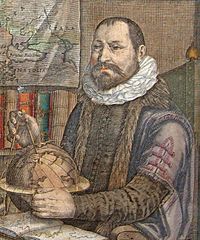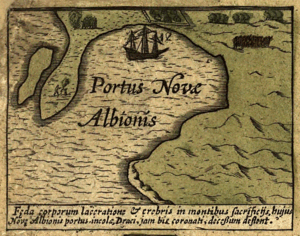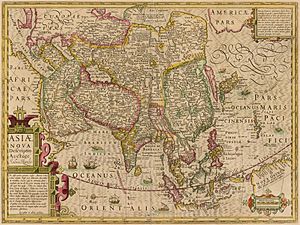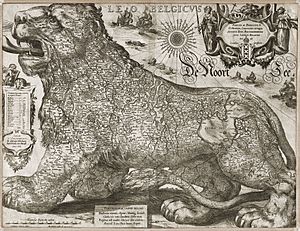Jodocus Hondius facts for kids
Quick facts for kids
Jodocus Hondius
|
|
|---|---|

Jodocus Hondius on a 1619 engraving
|
|
| Born | 14 October 1563 Wakken, Belgium
|
| Died | 12 February 1612 (aged 48) Amsterdam, The Netherlands
|
| Scientific career | |
| Fields | Cartography |
| Influences | Gerardus Mercator |
| Influenced | Jan Janssonius, Henricus Hondius II |
Jodocus Hondius (born Joost de Hondt) was a famous engraver and mapmaker from Flanders. He lived from 1563 to 1612. People sometimes call him Jodocus Hondius the Elder. This helps tell him apart from his son, Jodocus Hondius II.
Hondius was known for his early maps of the Americas and Europe. He also helped make the maps of Gerardus Mercator popular again. Hondius created portraits of the famous explorer Francis Drake. He was an important figure during the Dutch Golden Age of mapmaking. He helped make Amsterdam a main center for maps in the 17th century.
Jodocus Hondius's Life
Hondius was born in Wakken, Belgium. He grew up in Ghent. When he was young, he became skilled at engraving. He also made tools and globes. In 1584, he moved to London, England. He left his home country because of religious problems.
In London, in 1587, he got married. He also worked with his wife's brother, Pieter van den Keere. Pieter was also a mapmaker and engraver.

While in England, Hondius helped share the story of Francis Drake. Drake had sailed around the world in the late 1570s. In 1589, Hondius made a famous map of New Albion bay. This was a place where Drake briefly settled on the west coast of North America. Hondius's map was based on what people saw and wrote during Drake's trip. It helped people guess where Drake landed. Today, many think it was at Drakes Estero in California. Hondius also drew several well-known pictures of Drake. These pictures are now in the National Portrait Gallery, London.

In 1593, Hondius moved to Amsterdam. He stayed there for the rest of his life. In 1604, he bought the printing plates for Gerardus Mercator's Atlas. He bought them from Mercator's grandson. Mercator's maps were not as popular as those by Abraham Ortelius at the time.
Hondius printed Mercator's work again. He added 36 new maps, some of which he made himself. Even with his own maps, Hondius gave Mercator full credit. He listed himself only as the publisher. Hondius's new edition of Mercator's Atlas was a huge success. It sold out in just one year! Hondius later made a second edition. He also made a smaller, pocket-sized version called Atlas Minor. These maps are now known as the "Mercator/Hondius series." Hondius also taught his cousin, Abraham Goos, how to make maps and engrave.
In the French version of the Atlas Minor, there is a map called Designatio orbis christiani (1607). This map showed where different religions were found. It was one of the first maps to use symbols to show different types of information.
Between 1605 and 1610, Hondius worked for John Speed. He engraved the plates for Speed's book, The Theatre of the Empire of Great Britaine.

Hondius died in Amsterdam when he was 48 years old. After he passed away, his family kept his map business going. His wife, his two sons (Jodocus II and Henricus Hondius II), and his son-in-law Jan Janssonius continued his work. Janssonius's name appeared on the Atlas as a co-publisher after 1633.
Over time, about 50 different versions of the Atlas were printed. They were in many European languages. Some parts of the atlas were even translated into Turkish. This series of maps is sometimes called the "Mercator/Hondius/Janssonius" series. This is because Janssonius added more maps later on.
Globes in Famous Paintings
Some experts believe that the globes in two famous paintings by Johannes Vermeer were based on globes made by Hondius. These paintings are The Astronomer (1668) and The Geographer (1669).
If you look closely at the globes in these paintings, they look very much like a pair of globes Hondius made in 1618. Hondius made these globes as a set. One showed the Earth, and the other showed the stars and constellations.
In Vermeer's The Astronomer, the scholar is looking at a version of Hondius's star globe. In The Geographer, Hondius's Earth globe can be seen on top of a cabinet. You can find a version of Hondius's star globe at the Nederlands Scheepvaartmuseum in Amsterdam. The Earth globe is at The Hispanic Society Museum & Library in New York City.
Honours
Hondius Inlet in Antarctica is named after Jodocus Hondius.
See also
 In Spanish: Jodocus Hondius para niños
In Spanish: Jodocus Hondius para niños

